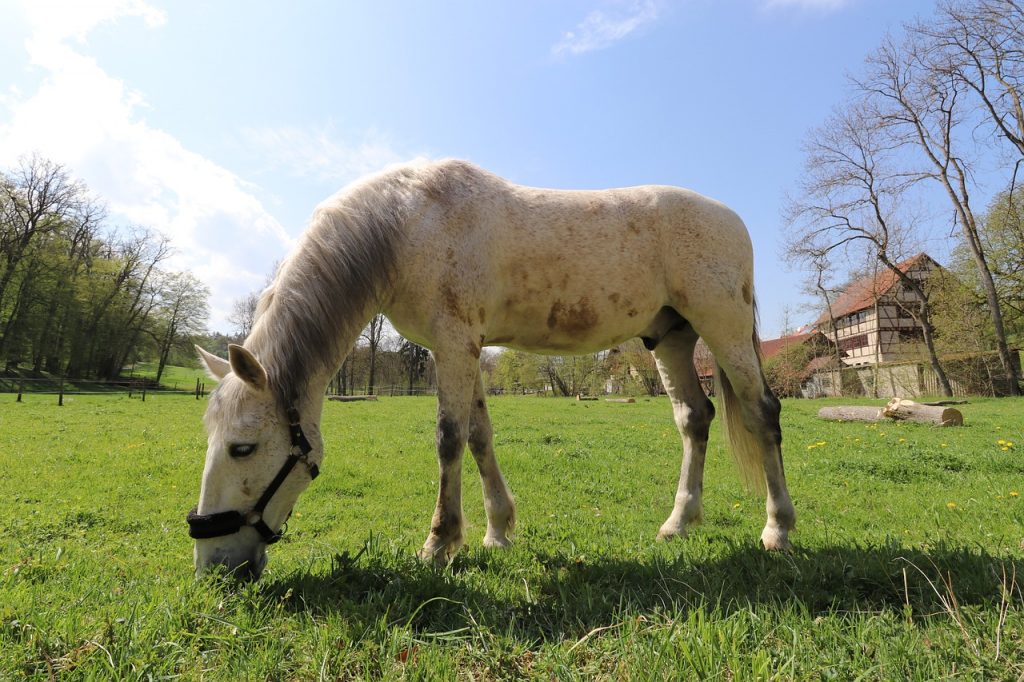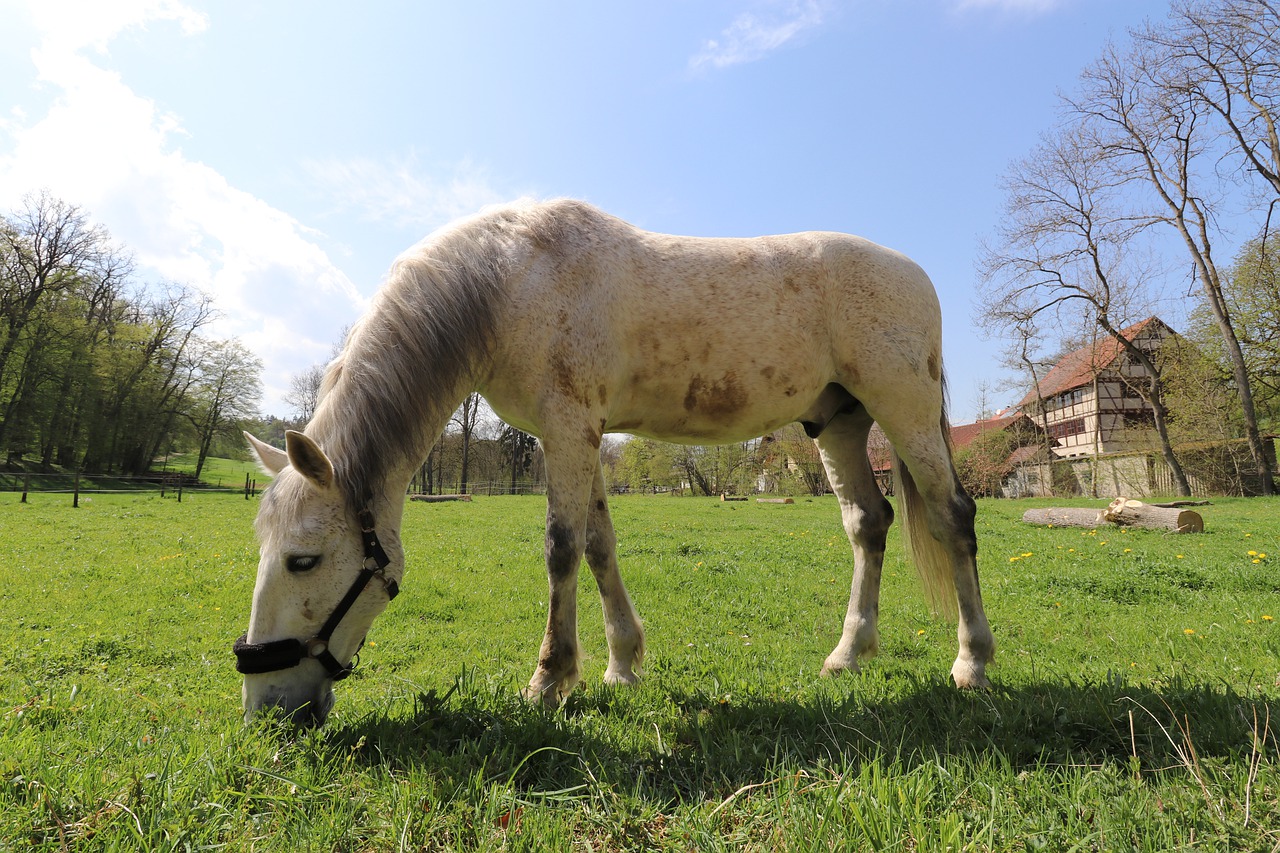Last Updated on March 29, 2022 by Allison Price
Bog Spavin (Inflammation at the Hock Joint).
Bog spavin refers to inflammation of the synovial membrane, which results in the distention of the joint capsule around the tarsal joint (hock). This could be due to congenital defects, degenerative joint disease or trauma, poor joint conformation, infection or an unknown cause (idiopathic). Depending on the cause, lameness could be present or not.
The joint swelling can be seen mainly at the hock’s middle back, with smaller swellings to the sides and near the back. Although it rarely affects the horse’s ability to use the horse, idiopathic bog spavin can be considered a cosmetic problem. A veterinarian should examine the horse and take x-rays to ensure that there aren’t any structural changes. In yearlings and weanlings, hock swelling can appear and disappear by itself.
A veterinarian may use a needle and/or syringe to remove excess fluid from the joint membrane. The joint may be treated with corticosteroid injections. These provide temporary and variable relief. An endoscope can be used to perform surgery if bone or cartilage involvement is suspected or known. Bog spavin is more likely to recur in cases of poor conformation.
Bone Spavin
Osteoarthritis (bone spavin) is a condition that causes bone pain and joint cartilage loss. The hock has many joints, so one or more could be affected. While bone spavin is most commonly associated with lameness, it may not always be apparent, particularly early in life. It is possible that the cause of lameness isn’t always obvious. This could be due to poor conformation, excessive jarring injury or mineral imbalance. All breeds are susceptible to this condition.

Horses that are lame tend to drag their toes. The forward movement of horses is reduced and the hock action is diminished. Lameness may be permanent if the joints’ surfaces are affected. The heel can become longer. Spavin can cause soreness in the gluteal muscles, which is known as trochanteric Bursitis. This can occur when horses are racing, jumping, or other sport horses. Standing, the horse might rest his toes on the ground with his heel slightly elevated. Exercise can often make the lameness disappear and return after rest. Sometimes, the bones of affected joints can fuse naturally and lead to a return back to soundness.
The horse’s history and physical examination are used to diagnose bone spavin. X-rays can also be taken to check for abnormal bony growth and joint degeneration. To pinpoint the source of the pain, local anesthesia may be required for each tarsal joint and nerves to the affected leg.
Injecting corticosteroids into the joint in the initial stages may be helpful. Signs may be reduced or eliminated by nonsteroidal anti-inflammatory drugs, such as phenylbutazone. Most joints are not affected by a wide range of motion. They may fuse naturally or through veterinary intervention. This can relieve the pain and make the horse more comfortable. While corrective shoeing may be helpful in milder cases, rolling the toe and raising the heels can help with lameness.
Curb
Curb refers to thickening or bowing in the plantar-tarsal ligament, which runs down the back side of the hock. This is usually due to strain. The ligament can become inflamed or thickened from falling, slipping and jumping. This condition is more common in Standardbreds. Horses with poor conformation of their hocks are more likely to get it. If you observe the horse sideways, you may notice a swelling of the bone approximately 4 inches (10 cm) below the point. A curb that has recently been formed can cause inflammation and lameness. Horses favor the heel raised and stand. Chronic curb cases rarely cause lameness or pain.
Acute cases should be treated with cold packs and rest. Poor conformation of the hock can lead to little relief. The problem is self-limiting and does not have any lasting impact on performance.
Displacement of the Superficial Flexor Tendon at the Point of the Hock
Damage to the attachment of the superficial flexor tendon to the point on the hock can cause the tendon to become dislocated. The injury is usually caused by a sudden bend of the hip. After that, the tendon can slip to the side (more often) or inside the hock. Initial symptoms include a severe and sudden loss of limb, as well as heat and swelling. The treatment involves resting for 3 months or more, possibly with a cast. A permanently displaced tendon may result in a jerky hock and a horse with a displaced flexor tendon. Although this is not a problem for jumping or fast exercise, it can affect dressage movements. Although surgery has been performed in a few cases, it is not recommended for larger horses.
Fracture of Tarsus
Trauma or complications of degenerative joint diseases can cause fractures of the tarsus and hock. There are many possible fractures in the hock, which is a complex joint that is made up 8 bones. A careful x-ray exam is required to confirm the diagnosis.
Chip fractures are one of the most common fractures in the tarsus. Slab fractures can also be seen in racehorses. These are often very small and do not cause lameness. Your veterinarian may use local anesthesia to identify the area of lameness. A rest period of three to six months is usually sufficient for complete recovery. However, with large chips, surgical removal may be necessary. This condition can be treated with an endoscope. The placement of bone screws may be necessary for slab fractures.
Hindlimb Tendon, Muscle Ruptures
Horses rarely break the Achilles tendon, which includes both the calf muscle (and the superficial flexor tendon). However, the chances of recovery are good. The horse’s hock falls to the ground and becomes unable to support weight.
Gastrocnemius is calf muscle rupture. This can be caused by excessive stress to the hock such as when the horse must stop suddenly. This can affect both the hindlimbs. Although weight and body weight can be carried, excessive bending of the hip can make it difficult to walk. There is no satisfactory treatment. Although splinting the limb or slinging the horse are possible, they are often unsuccessful.
Injuries to the extensor tendon and digital extensors are common in hindlimb tears. The chances of recovery are usually good if only one tendon is affected. The horse may lose its ability to perform well if both extensor tendon are damaged. However, it may still be useful for slow work or breeding. If both tendons are severed, conservative treatment can heal it. However, if the horse is unable to perform at its best or wants to return to performance, surgical repair or casting should be considered.
Sometimes, racing injuries can cause the deep and superficial flexor tendons to rupture. When other tendons become torn, the tendons can also burst. These injuries can cause severe lameness, overextension of the pastern and fetlock, and may result in severe injury. The treatment involves surgical repair that includes casting and splinting the limb. However, the prospects of future performance are poor.
Injuries to the fibularis or peroneus muscles can affect the hindlimb, disrupting the action of the hip and stifle joints. This condition has the most distinctive characteristic of being able to simultaneously extend the hock while flexing the stifle. Although the horse may be lame, he or she is usually able to support weight on one limb. As the hindlimb is moved forward, it exhibits a jerking motion. Ultrasonography can confirm diagnosis based on clinical signs. A prolonged period of rest, usually 4 months, is recommended. The outlook for recovery is good.
Stringhalt
Stringhalt refers to the involuntary contraction of one or both hindlimb muscles. It is also known as an exaggerated upward movement of the joints during a walk. There may be some degree of joint overflexion. In mild cases, the horse may lift the foot and lower it. In extreme cases, the foot is pulled up sharply until it touches the stomach and is then struck on the ground. Mild stringhalt can occur at any time. Signs may diminish or even disappear during warmer weather. Signs are most evident when horses are backed or turned sharply. Sometimes, the signs are only apparent when the horse gets out of its stall. Stringhalt does not affect the horse’s ability or ability to work. However, it can cause secondary complications in extreme cases. This condition can also render the horse ineligible for equestrian sports, such as dressage.
Although the cause of this condition is not known, it could be caused by an abnormality in nerves in the hindlimbs. It is possible that the muscles of the legs may have atrophy. Nerve disorders are usually on one side. They may resolve themselves spontaneously. Long-term cases may be treated with surgical extensor cutting, which includes the removal of a portion or all of the muscle. However, improvement may not be apparent until two to three weeks after surgery. Recovery after surgery is a delicate process. Not all patients will respond.
The grazing of toxic plants in New Zealand, Australia, and the United States has been linked to severe forms. The condition can affect both the hindlimbs and may be resolved by removing the infected plants from the pastures. This condition is most common in the fall or later summer.
The diagnosis is made based on the veterinarian’s examination. However, electromyography can confirm the diagnosis. This measures the electrical activity in the muscles and nerves. Sometimes, false stringhalt can be caused by temporary irritation to the lower foot or a sore in the foot. Sometimes, a horse may exhibit a stringhalt-like gait with a momentary locking of the patella (kneecap) extended.
Thoroughpin
Thoroughpin refers to a swelling that occurs just above the hock and is caused by the thickening of the digital flexor tendon. It’s distinguished from bog spavin by fluid-filled swellings that appear on both sides of the tarsal joints. It typically affects one limb and can vary in size. It usually does not cause lameness, and can resolve by itself. Thoroughpin, which is essentially a blemish on horses, is crucial for show horses. The fluid can be removed and injected with hyaluronic or a long-acting, corticosteroid. The procedure can be repeated until the swelling stops returning. Radiation therapy can also be used to reduce fluid buildup in the tendon sheath.
Direct trauma can cause Thoroughpin. This causes inflammation and bleeding in the tendon sheath. This can be treated with rest, local or systemic anti-inflammatory drugs and cold therapy. Infections can occur depending on the trauma and may require antibiotic therapy.


